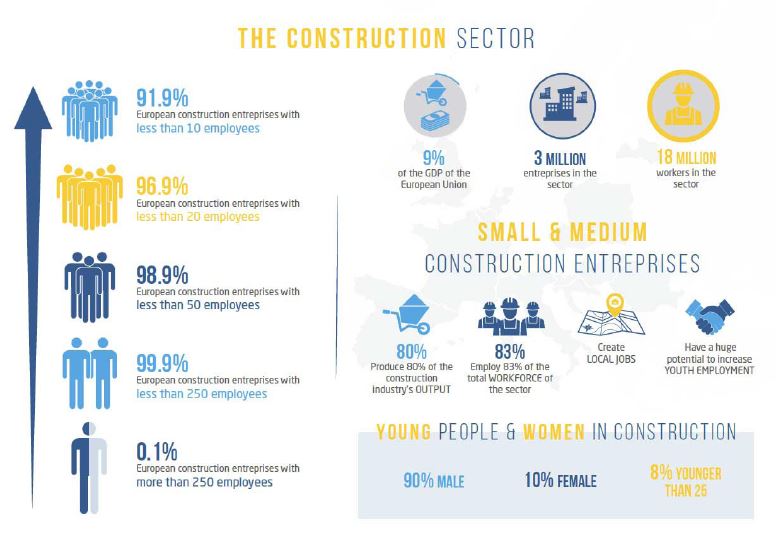
By Riccardo Viaggi, Secretary General, European Builders Confederation
The construction sector is one of the main pillars of the European economy and provides solutions for social, climate and energy challenges. By making up for 9% of the GDP of the European Union (EU) with its total turnover of €1,241 billion in 2015, it is in fact the single industrial sector with the highest contribution to the EU’s GDP. There are 3 million enterprises active in this sector, 92% of which have less than 10 workers. Furthermore, construction companies employ a direct workforce of 18 million people, adding to the sectors’ vital importance for our society.
However, the construction sector and its SMEs were severely hit by the financial crisis, suffering from the double-dip recession close to the 2008 meltdown. Since then the construction industry has been shrinking. But businesses are seeing some encouraging signs, which would benefit both the sector and the European Union as a whole, because every job created in construction results in two additional jobs elsewhere, as a Commission analysis claims. Hence it is of vital importance to bring the construction sector back on track.
The Renovation Market as a Key Opportunity
The most promising way to put the construction sector up to its old strength is by stimulating the renovation sector, which represented 57% of the construction sector’s turnover in 2015, a strong increase from 47% in 2005. A constantly growing part of this work is made up by energy renovation works. In fact, buildings are responsible for about 41% of total energy consumption and thus form an integral part in reaching the goals set within the 2030 framework for climate and energy, and in achieving the COP21 commitments. Compensating for other sectors where it is even more difficult or less cost effective to reduce emissions, buildings need to move towards being “nearly-zero carbon”. A promising chance for the construction sector to return to its state before the crisis hit Europe and even excel it.
In 2015 energy efficiency improvement works were worth over €100 billion, roughly 15% of the total turnover of construction activities in the EU. The vast majority of this turnover is created in the housing sector. A continuous increase in the coming years has the potential to boost the EU’s energy performance and to increase employment numbers, especially among young people in local areas. In 2015 energy renovation works employed directly close to 900,000 people.
Financing Energy Efficiency is the Biggest Challenge
However, one of the biggest issues hampering the increase of energy renovations lies in the structure of the existing building stock and its related financing possibilities.
75% of the square meters in the existing housing stock in the EU lie in residential buildings. Considering that about 65% of the energy renovation works are done in this kind of housing stock, it is also the most important sector for construction companies. In fact, by looking at the data in a bit more detail it becomes visible that 70% of people in the EU live in a self-owned flat and about 60% of the EU population in an individual house. It is also worth noting that about 43% of the people who own a house don’t have a mortgage on it. Therefore, split incentive issues between landlords and tenants are less of a problem. Instead, providing private landlords with information and adequate as well as attractive financial incentives to enhance the energy efficiency of their building is one of the main tasks ahead.
The challenge of boosting the energy efficiency of existing buildings can only be met if sufficient and stable financial incentives are made available and easily accessible. Indeed, energy efficiency in housing is an interesting issue for homeowners as European households spend on average 6% of their expenses on heating/cooling. Nonetheless, it is slowed down by the fact that upfront costs are often high with a long return on investment. Therefore, it is essential that private owners/tenants are put in a position where they can afford to start retrofitting works to improve the energy performance of their building.
The European Builders Confederation Supports the Energy Efficient Mortgage Initiative
The European Builders Confederation thus considers the European Energy Efficient Mortgage initiative (see here) of the European Mortgage Federation – European Covered Bond Council (EMF-ECBC) an effective way to unlock the market potential and supports its launch. This initiative offers better borrowing rates on mortgages in return for either purchasing more energy efficient homes or committing to implement energy saving works within properties via the use of preferential interest rates. In this way it gives incentives to new homeowners to invest in energy efficiency measures and thus to strongly reduce the total energy consumption of buildings in the EU.
Boosting the energy renovation market is indispensable to help the EU reach its ambitious energy and climate goals. Additionally, it offers the chance to develop a true energy renovation market that can boost the economy, because the renovation of the building stock is a labour-intensive activity. A prediction by Ehrhardt-Martinez and Laitner (2008) for example states that 8.1 jobs, directly and indirectly related to the construction sector, are created per €1 million invested in energy renovation: a fact that does not only help the construction sector out of the still tangible crisis but also gives a push to the EU economy as a whole.
 By Riccardo Viaggi, Secretary General, European Builders Confederation
By Riccardo Viaggi, Secretary General, European Builders Confederation
The construction sector is one of the main pillars of the European economy and provides solutions for social, climate and energy challenges. By making up for 9% of the GDP of the European Union (EU) with its total turnover of €1,241 billion in 2015, it is in fact the single industrial sector with the highest contribution to the EU’s GDP. There are 3 million enterprises active in this sector, 92% of which have less than 10 workers. Furthermore, construction companies employ a direct workforce of 18 million people, adding to the sectors’ vital importance for our society.
However, the construction sector and its SMEs were severely hit by the financial crisis, suffering from the double-dip recession close to the 2008 meltdown. Since then the construction industry has been shrinking. But businesses are seeing some encouraging signs, which would benefit both the sector and the European Union as a whole, because every job created in construction results in two additional jobs elsewhere, as a Commission analysis claims. Hence it is of vital importance to bring the construction sector back on track.
The Renovation Market as a Key Opportunity
The most promising way to put the construction sector up to its old strength is by stimulating the renovation sector, which represented 57% of the construction sector’s turnover in 2015, a strong increase from 47% in 2005. A constantly growing part of this work is made up by energy renovation works. In fact, buildings are responsible for about 41% of total energy consumption and thus form an integral part in reaching the goals set within the 2030 framework for climate and energy, and in achieving the COP21 commitments. Compensating for other sectors where it is even more difficult or less cost effective to reduce emissions, buildings need to move towards being “nearly-zero carbon”. A promising chance for the construction sector to return to its state before the crisis hit Europe and even excel it.
In 2015 energy efficiency improvement works were worth over €100 billion, roughly 15% of the total turnover of construction activities in the EU. The vast majority of this turnover is created in the housing sector. A continuous increase in the coming years has the potential to boost the EU’s energy performance and to increase employment numbers, especially among young people in local areas. In 2015 energy renovation works employed directly close to 900,000 people.
Financing Energy Efficiency is the Biggest Challenge
However, one of the biggest issues hampering the increase of energy renovations lies in the structure of the existing building stock and its related financing possibilities.
75% of the square meters in the existing housing stock in the EU lie in residential buildings. Considering that about 65% of the energy renovation works are done in this kind of housing stock, it is also the most important sector for construction companies. In fact, by looking at the data in a bit more detail it becomes visible that 70% of people in the EU live in a self-owned flat and about 60% of the EU population in an individual house. It is also worth noting that about 43% of the people who own a house don’t have a mortgage on it. Therefore, split incentive issues between landlords and tenants are less of a problem. Instead, providing private landlords with information and adequate as well as attractive financial incentives to enhance the energy efficiency of their building is one of the main tasks ahead.
The challenge of boosting the energy efficiency of existing buildings can only be met if sufficient and stable financial incentives are made available and easily accessible. Indeed, energy efficiency in housing is an interesting issue for homeowners as European households spend on average 6% of their expenses on heating/cooling. Nonetheless, it is slowed down by the fact that upfront costs are often high with a long return on investment. Therefore, it is essential that private owners/tenants are put in a position where they can afford to start retrofitting works to improve the energy performance of their building.
The European Builders Confederation Supports the Energy Efficient Mortgage Initiative
The European Builders Confederation thus considers the European Energy Efficient Mortgage initiative (see here) of the European Mortgage Federation – European Covered Bond Council (EMF-ECBC) an effective way to unlock the market potential and supports its launch. This initiative offers better borrowing rates on mortgages in return for either purchasing more energy efficient homes or committing to implement energy saving works within properties via the use of preferential interest rates. In this way it gives incentives to new homeowners to invest in energy efficiency measures and thus to strongly reduce the total energy consumption of buildings in the EU.
Boosting the energy renovation market is indispensable to help the EU reach its ambitious energy and climate goals. Additionally, it offers the chance to develop a true energy renovation market that can boost the economy, because the renovation of the building stock is a labour-intensive activity. A prediction by Ehrhardt-Martinez and Laitner (2008) for example states that 8.1 jobs, directly and indirectly related to the construction sector, are created per €1 million invested in energy renovation: a fact that does not only help the construction sector out of the still tangible crisis but also gives a push to the EU economy as a whole.

This article was originally published in the November 2016 edition of the EMF-ECBC Market Insights and Updates newsletter. Please note that any views or opinions expressed in this article are those of the authors and not necessarily those of the EMF-ECBC. This article does not constitute investment advice.
By Riccardo Viaggi, Secretary General, European Builders Confederation
By Riccardo Viaggi, Secretary General, European Builders Confederation
The construction sector is one of the main pillars of the European economy and provides solutions for social, climate and energy challenges. By making up for 9% of the GDP of the European Union (EU) with its total turnover of €1,241 billion in 2015, it is in fact the single industrial sector with the highest contribution to the EU’s GDP. There are 3 million enterprises active in this sector, 92% of which have less than 10 workers. Furthermore, construction companies employ a direct workforce of 18 million people, adding to the sectors’ vital importance for our society.
However, the construction sector and its SMEs were severely hit by the financial crisis, suffering from the double-dip recession close to the 2008 meltdown. Since then the construction industry has been shrinking. But businesses are seeing some encouraging signs, which would benefit both the sector and the European Union as a whole, because every job created in construction results in two additional jobs elsewhere, as a Commission analysis claims. Hence it is of vital importance to bring the construction sector back on track.
The Renovation Market as a Key Opportunity
The most promising way to put the construction sector up to its old strength is by stimulating the renovation sector, which represented 57% of the construction sector’s turnover in 2015, a strong increase from 47% in 2005. A constantly growing part of this work is made up by energy renovation works. In fact, buildings are responsible for about 41% of total energy consumption and thus form an integral part in reaching the goals set within the 2030 framework for climate and energy, and in achieving the COP21 commitments. Compensating for other sectors where it is even more difficult or less cost effective to reduce emissions, buildings need to move towards being “nearly-zero carbon”. A promising chance for the construction sector to return to its state before the crisis hit Europe and even excel it.
In 2015 energy efficiency improvement works were worth over €100 billion, roughly 15% of the total turnover of construction activities in the EU. The vast majority of this turnover is created in the housing sector. A continuous increase in the coming years has the potential to boost the EU’s energy performance and to increase employment numbers, especially among young people in local areas. In 2015 energy renovation works employed directly close to 900,000 people.
Financing Energy Efficiency is the Biggest Challenge
However, one of the biggest issues hampering the increase of energy renovations lies in the structure of the existing building stock and its related financing possibilities.
75% of the square meters in the existing housing stock in the EU lie in residential buildings. Considering that about 65% of the energy renovation works are done in this kind of housing stock, it is also the most important sector for construction companies. In fact, by looking at the data in a bit more detail it becomes visible that 70% of people in the EU live in a self-owned flat and about 60% of the EU population in an individual house. It is also worth noting that about 43% of the people who own a house don’t have a mortgage on it. Therefore, split incentive issues between landlords and tenants are less of a problem. Instead, providing private landlords with information and adequate as well as attractive financial incentives to enhance the energy efficiency of their building is one of the main tasks ahead.
The challenge of boosting the energy efficiency of existing buildings can only be met if sufficient and stable financial incentives are made available and easily accessible. Indeed, energy efficiency in housing is an interesting issue for homeowners as European households spend on average 6% of their expenses on heating/cooling. Nonetheless, it is slowed down by the fact that upfront costs are often high with a long return on investment. Therefore, it is essential that private owners/tenants are put in a position where they can afford to start retrofitting works to improve the energy performance of their building.
The European Builders Confederation Supports the Energy Efficient Mortgage Initiative
The European Builders Confederation thus considers the European Energy Efficient Mortgage initiative (see here) of the European Mortgage Federation – European Covered Bond Council (EMF-ECBC) an effective way to unlock the market potential and supports its launch. This initiative offers better borrowing rates on mortgages in return for either purchasing more energy efficient homes or committing to implement energy saving works within properties via the use of preferential interest rates. In this way it gives incentives to new homeowners to invest in energy efficiency measures and thus to strongly reduce the total energy consumption of buildings in the EU.
Boosting the energy renovation market is indispensable to help the EU reach its ambitious energy and climate goals. Additionally, it offers the chance to develop a true energy renovation market that can boost the economy, because the renovation of the building stock is a labour-intensive activity. A prediction by Ehrhardt-Martinez and Laitner (2008) for example states that 8.1 jobs, directly and indirectly related to the construction sector, are created per €1 million invested in energy renovation: a fact that does not only help the construction sector out of the still tangible crisis but also gives a push to the EU economy as a whole.
 This article was originally published in the November 2016 edition of the EMF-ECBC Market Insights and Updates newsletter.
This article was originally published in the November 2016 edition of the EMF-ECBC Market Insights and Updates newsletter.

 By Riccardo Viaggi, Secretary General, European Builders Confederation
By Riccardo Viaggi, Secretary General, European Builders Confederation